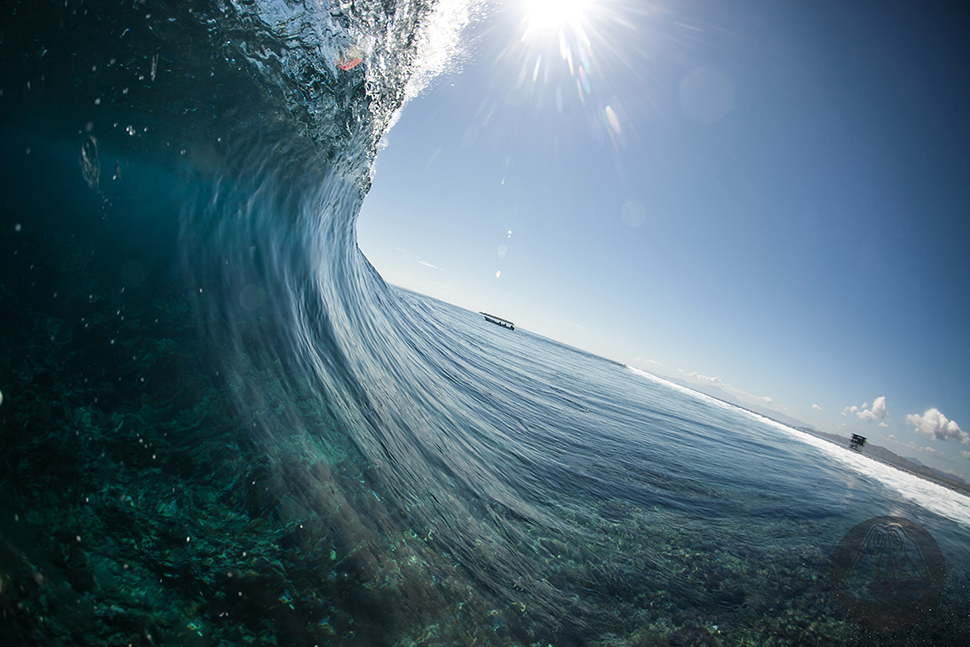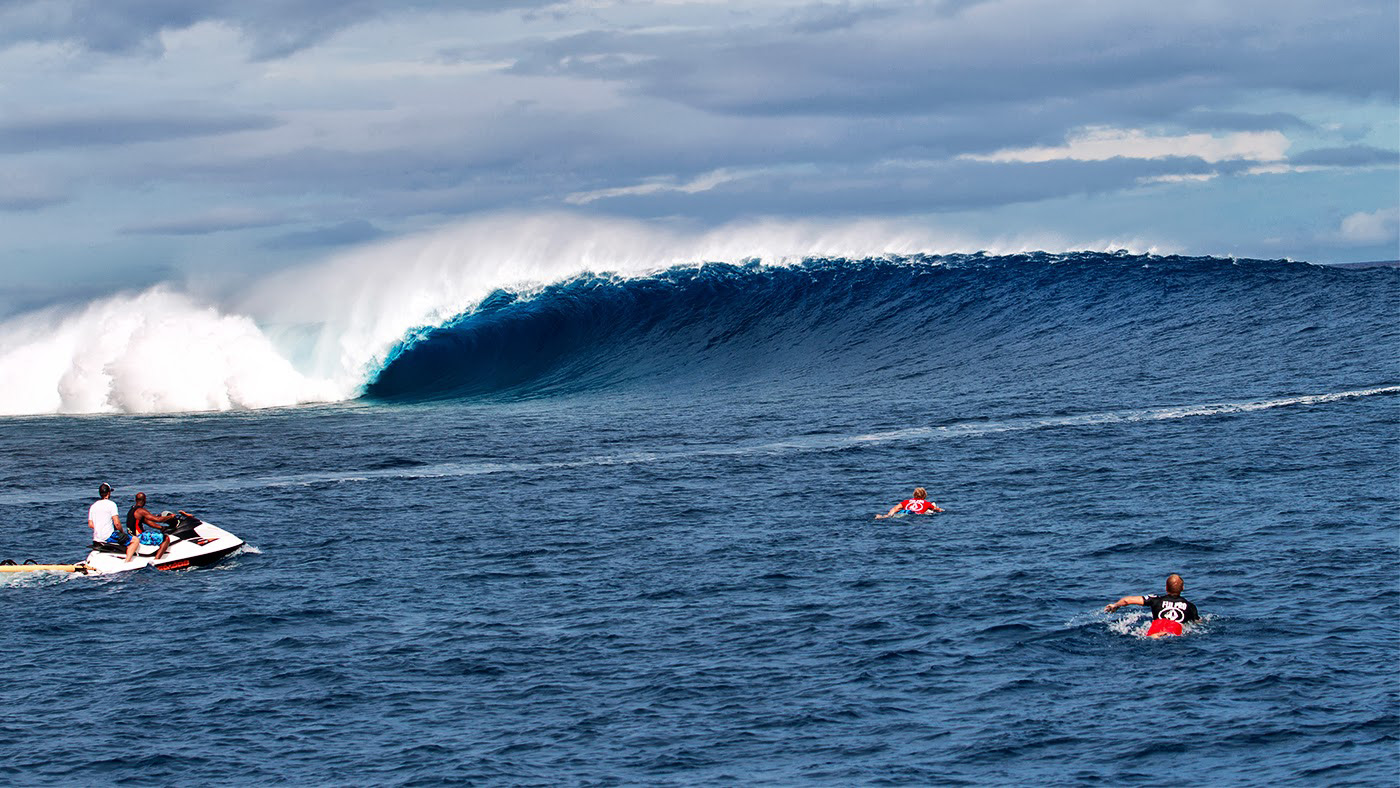Cloudbreak / Fiji – Surf,Bodyboard – Tavarua – Viti Levu

 Surfergalaxy
Surfergalaxy 
| Wave | Left |
| Ola | Izquierda |
| Wind | NE |
| Tide | All |
| Marea | Todas |
| Swell | S - SW |
| Bottom | Coral Reef |
| Fondo | Arrecife de Coral |
| Time of year | From April to October |
| Época del año | De Abril a Octubre |
Here in the middle of the Pacific Ocean, like Hawaii or Tahiti, the swell doesn’t pass any obstacles that brake it during its voyage until it reaches the Cloudbreak reef and so this creates more powerful waves than those that reach the continental shelves. It’s recommended to use longer boards.
Cloudbreak is a very fast and powerful wave suitable only for experienced surfers since it starts breaking at 6 ft and holds it all from there. The best swell direction is usually from the south and southwest, with more west, the wave is faster and hollower. The best wind direction is northeast, but of course it’s better glassy. Regarding the tide, all are good but for the most experienced, a falling tide always works best.
Cloudbreak is often subdivided into three main sections; the first ‘the Point’ is the take off area, the second ‘the Middle’ breaks shallowly and barrels until the last and most tricky section, known as ‘Shish Kebabs’ and this is where a mistake could become a problem, especially if it is one of the first waves of the set. Keep in mind that the sets are frequent and have 7, 8 waves so if you fall in a bad place in one of the first it’s no joke. Cloudbreak breaks offshore making it easy to enter the sets with small angle variations that require you to be very attentive. The take off zone on the outside is known as ‘the Ledge’ precisely because you have to wait for the set a little further away than usual to anticipate the differences in direction between sets. It’s a factor that isn’t usually taken into account but it’s crucial to surf it successfully.
En medio del Oceano Pacífico, al igual que en Hawai o Tahití el swell durante su viaje oceánico no encuentra ningún obstáculo que lo frene hasta que llega al arrecife de Cloudbreak, esto significa que las olas rompen con más energía que las que llegan a las plataformas continentales, siendo recomendable usar tablas un poco más largas.
Cloudbreak es una ola muy potente solo para surfers experimentados, empieza a romper propiamente con 6 pies y a partir de ahí lo aguanta todo. La mejor dirección del swell es de sur y suroeste, cuanto más oeste más rápida y hueca, el mejor viento es noreste, pero sin duda mejor glassy, respecto a la marea todas son buenas pero para los que sean más rápidos siempre funciona mejor bajando.
Cloudbreak posee tres secciones principales, la primera es ‘the Point’, la zona de take off, la segunda ‘the Middle’ es un tubo hasta la última sección conocida como ‘Shish Kebabs’, en esta última un fallo puede ser un problema, sobre todo si se trata de una de las primeras olas de la serie, hay que tener en cuenta que son frecuentes series de 7, 8 olas y caer en mal sitio en una de las primeras no es ninguna broma. Cloudbreak rompe en mar abierto siendo fácil que entren series con pequeñas variaciones de ángulo que exigen estar muy atento. La zona de take off en el ouside es conocida como ‘the Ledge’, en ella hay que esperar la serie un poco más retirado para anticiparse a esas diferencias de dirección entre las series, es un factor que no se suele tener en cuenta y es crucial para coger buenas olas.

The Cloudbreak left, has such great significance that surfing cannot be understood without it. It is located south of the atoll of the small island Tavarua, 26 kilometres west of Viti Levu, the largest island of the Fiji achipelago. Its location in the middle of the Pacific Ocean with the deep water surrounding it makes it a renowned big wave spot that many big wave riders wait patiently for when the strong swell from the Tasman Sea channels towards Fiji and creates huge barrels like Pipeline but five times longer. It is undoubtedly one of the three most spectacular stops of the ‘Dream Tour’ along with Teahupo and Pipeline. Just check out the final between Kelly Slater and Mick Fanning in the last Volcom Fiji Pro 2013 to understand Cloudbreak better.
Nadi Airport is in Viti Levu and it’s the hub from where you’ll begin your journey. The accommodation options are varied, there are luxury resorts, surf camps or even the increasingly popular option of staying in one of the traditional bures or hostals that you’ll find around Nadi. It is advisable to take everything you’ll need to Fiji i.e. your entire quiver, various leashes and wax, etc. because it will be very difficult to find equipment there. Also, make sure that from where you are staying you have easy access to a boat to go to Cloudbreak.
Only a few years ago Tavarua was a private island where only a few priviliged could surf but fortunately, in July 2010, the Fijian government passed a law which meant that the reefs there or anywhere in Fiji are now open spaces and are not soley for private use. This was very positive because it meant that above all, a large amount of the local population could take advantage of the benefits of its resources and it also means that Cloudbreak is now within reach of more surfers. In relation to this, don’t forget that Tavarua is surrounded by waves but Fiji has over 300 atolls and about 100 inhabited virgin islands around it hiding undiscovered potential.
La Izquierda de Cloudbreak tiene un significado tan grande que actualmente no se entendería el surfing sin ella. Está situada al sur del atolón de la pequeña isla de Tavarua situada a 26 kilómetros al oeste de Viti Levu, la isla mayor del Archipiélago de Fiji. Su ubicación en medio del Océano Pacifico y rodeada de aguas profundas hace que sea un reconocido spot de olas grandes al que muchos «big wave riders» esperan con paciencia el momento en el cual, desde el Mar de Tasmania, un fuerte swell se dirija hacia Fiji para transformarse en forma de enormes tubos similares a Pipeline pero cinco veces más largos. Es sin duda una de las tres paradas más espectaculares del ‘Dream Tour’ junto a Teahupo y Pipeline, simplemente con ver la final entre Kelly Slater y Mick Fanning en el último «Volcom Fiji Pro 2013» se comprende un poco mejor lo que significa Cloudbreak.
En Viti Levu está el aeropuerto de Nadi, centro de operaciones desde el que empezarás tu viaje. Las opciones de alojamiento son variadas, hay lujosos resorts, surfcamps o también la posibilidad cada vez más popular de alojarte en alguno de los pequeños hostales o los típicos bures que se encuentran alrededor de Nadi. Es recomendable en Fiji traer un buen quiver y no olvidar varios leash y parafina, será muy difícil que aquí encuentres material. Presta mucha atención en el lugar donde te vayas a alojar, es muy importante que dispongan o faciliten un bote para ir a Cloudbreak.
Decir que hace poco tiempo Tavarua fue una isla privada en la que pocos privilegiados podían surfear, afortunadamente desde el 2 de julio de 2010, el Gobierno de Fiji aprobó una ley por la cual los arrecifes que allí o en cualquier lugar de Fiji existen sean espacios libres de apropiaciones y usos privados. Esto ha sido muy positivo porque ha posibilitado que, sobre todo, un mayor número de población local pueda aprovecharse del beneficio de sus recursos y aumente la oferta para que Cloudbreak esté al alcance de surfers con una capacidad adquisitiva más reducida. En relación a esto último no hay que olvidar que Tavarua está rodeada de olas, pero es que además, Fiji posee más de 300 atolones y alrededor de 100 islas vírgenes inhabitadas que esconden un potencial aún por descubrir.
Fiji is a multiracial country where over the years a great ethnic mosaic including Polynesians, Micronesians, Chinese and Europeans has been created but over 50% is indigenous Polynesian population and you can enjoy their traditional ceremonies, such as the Meke dance or the traditional Kava drink. Fiji is a natural spectacle comprised of volcanic islands, coral atolls, white beaches, lakes, forests, flowers and exotic tropical fruits. It’s perfect for snorkelling, fishing, kayaking, walking or renting a motorbike. Visit the Bouma National Park, play golf on one of the excellent golf courses that are out there, go diving in Pacific Harbour or visit the more traditional inner cities. Not everything in Fiji is about surf and the offer of alternative plans or activities is endless.
Fiji es un país multirracial donde el paso de los años ha creado un mosaico étnico espectacular, polinesios, micronesios, chinos, europeos. Más del 50 % es población polinesia autóctona con la que deberías de disfrutar de sus ceremonias tradicionales, por ejemplo el baile del Meke o la tradición del Kava. Fiji es un espectáculo natural formado de islas volcánicas, atolones de coral, playas blancas, lagos interiores, flores, exóticas frutas tropicales, selvas. Un lugar perfecto para bucear, pescar, coger un kayak, pasear, alquilar una moto. Visitar el Parque Nacional de Bouma o jugar en alguno de los excelentes campos de Golf que por allí se encuentran, bucear en Pacific Harbour o visitar ciudades interiores más tradicionales. Aquí no todo es surf y en Fiji la oferta de actividades o planes alternativos es infinita.